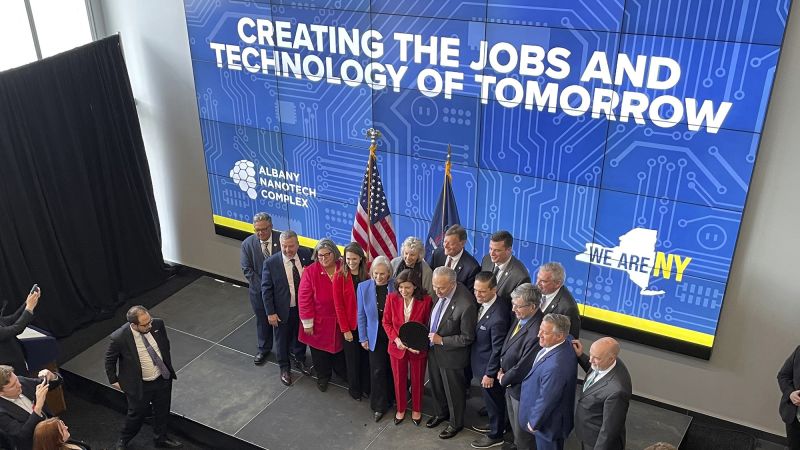A new $10 billion mega chip-making complex is coming to New York state.
Governor Kathy Hochul announced New York’s efforts to build a High NA Extreme Ultraviolet (EUV) Lithography research and development center. In a statement Monday, she said the state will invest $1 billion and join forces with chip industry giants including IBM, Micron and Applied Materials to move the project forward.
The center will create at least 700 new jobs and could generate an estimated $9 billion in private spending, according to the statement, as well as support talent development through a range of programs including within the workforce and K-12 STEM academic initiatives.
The “next-generation semiconductor research and development center” is set to be built at the Albany NanoTech Complex near the University of Albany, a 1.65 million square-foot complex that has been growing in stages since the 1990s. The complex is operated by NY CREATES, a nonprofit that will also oversee the new center’s construction and install new chip-making equipment acquired from Dutch machinery company ASML Holding.
NY CREATES is an acronym for New York Center for Research, Economic Advancement, Technology, Engineering and Science.
New York’s plans to expand microchip production are intended to enhance the state’s bid for research hub designation under the federal CHIPS and Science Act, a $53 billion bipartisan bill passed last year to help boost America’s chip manufacturing. With the designation, New York could unlock over $11 billion in federal funding with the designation.
“We have a focus on economic development, and it’s really to drive the innovation economy around the region of the Northeast as well as across the nation,” NY CREATES President David Anderson said Tuesday at an event hosted by the Center for Strategic & International Studies (CSIS).
New York has already made chip production a statewide priority: in January, Hochul announced the creation of the Governor’s Office of Semiconductor Expansion, Manufacturing, and Integration (GO-SEMI), a $45 million effort. Multiple large chip factories already call New York State home, and a $100 billion Micron-funded factory was announced last year.
“This investment in Albany NanoTech will reinforce New York’s position as a global leader in semiconductor research and development,” Senator Kirsten Gillibrand said in the statement. “Establishing this new semiconductor center will also bolster our national security, allowing the United States to develop the world’s most complex and powerful semiconductors right at home.”
Monday’s announcement shows a doubling down on the state’s continuing efforts to boost the economy and contribute to US efforts to renew semiconductor manufacturing, driven by economic and national security concerns. America is in the midst of an ongoing chip production battle with China, Russia, Iran and other countries, with new rules unveiled in October to further tighten a sweeping set of export controls first introduced last year.
The “US can’t afford to be behind again,” said Gaurav Gupta, a vice president and analyst of emerging technologies and trends at Gartner in an email to CNN. “[T]his will go a long way to create a center where researchers/engineers from private semiconductor companies can come together and work – NY state can become a semiconductor research and manufacturing hub.”
An international trade war over chip production has been a focal point of policy and discussion in recent years, with the US limiting the types of semiconductors American companies can sell to foreign countries and China announcing in July it would curb overseas exports of germanium and gallium, both essential for making semiconductors.
Semiconductors are also impacted by soaring global demand for artificial intelligence in the past year, with limits in the supply chain for powerful chips and export bans on some US companies to avoid shipping some chips to China.
Multiple companies including Microsoft and OpenAI have voiced concern over the limited supply of graphics processing units (GPUs) and the possible risk factor for investors.
“For the majority of our products, we have the ability to use other manufacturers if a current vendor becomes unavailable or unable to meet our requirements,” Microsoft CEO Satya Nadella wrote in a shareholder letter in October when discussing GPUs. “However, some of our products contain certain components for which there are very few qualified suppliers. Extended disruptions at these suppliers could impact our ability to manufacture devices on time to meet consumer demand.”
In another milestone Monday for US chip production, the Department of Commerce announced its first agreement under the CHIPS Act with the United Kingdom’s BAE Systems, Inc. in a $35 million deal going toward modernizing a New Hampshire facility to help quadruple chip production for military aircraft.
“Today’s announcement is the first step of many to come,” the White House wrote in a release. “It will advance our national security goals, and it will spur local investment and job creation.”
Read the full article here




